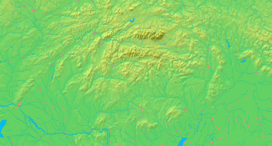Spiš Castle
| Spiš Castle (Spišský hrad) | |
| Castle | |
 Spiš Castle | |
| Country | Slovakia |
|---|---|
| Region | Košice |
| District | Spišská Nová Ves |
| Municipality | Žehra |
| Elevation | 634 m (2,080 ft) |
| Coordinates | SK 49°00′02″N 20°46′06″E / 49.00056°N 20.76833°ECoordinates: SK 49°00′02″N 20°46′06″E / 49.00056°N 20.76833°E |
| Area | 41,426 m2 (445,906 sq ft) |
| Styles | Romanesque, Gothic, Renaissance |
| Material | masonry |
| Founded | 12th century |
| Abandoned | 1760 |
| Visitation | 170,000 (2006) |
| UNESCO World Heritage Site | |
| Name | Levoča, Spišský Hrad and the Associated Cultural Monuments |
| Year | 1993 (#17) |
| Number | 620 |
| Region | Europe and North America |
| Criteria | iv |
  Location of Spiš Castle in Slovakia
| |
  Location of Spiš Castle in the Košice Region
| |
| Wikimedia Commons: Spiš Castle | |
The ruins of Spiš Castle (Slovak: Spišský hrad, ![]() pronunciation ; Hungarian: Szepesi vár; German: Zipser Burg) in eastern Slovakia form one of the largest castle sites in Central Europe. The castle is situated above the town of Spišské Podhradie and the village of Žehra, in the region known as Spiš (Hungarian: Szepes, German: Zips, Polish: Spisz, Latin: Scepusium). It was included in the UNESCO list of World Heritage Sites in 1993 (together with the adjacent locations of Spišská Kapitula, Spišské Podhradie and Žehra). This is one of the biggest European castles by area (41 426 m²).
pronunciation ; Hungarian: Szepesi vár; German: Zipser Burg) in eastern Slovakia form one of the largest castle sites in Central Europe. The castle is situated above the town of Spišské Podhradie and the village of Žehra, in the region known as Spiš (Hungarian: Szepes, German: Zips, Polish: Spisz, Latin: Scepusium). It was included in the UNESCO list of World Heritage Sites in 1993 (together with the adjacent locations of Spišská Kapitula, Spišské Podhradie and Žehra). This is one of the biggest European castles by area (41 426 m²).
History


Spiš Castle was built in the 12th century on the site of an earlier castle. It was the political, administrative, economic and cultural centre of Szepes County[1] of the Kingdom of Hungary. Before 1464, it was owned by the kings of Hungary, afterwards (until 1528) by the Zápolya family, the Thurzó family (1531–1635), the Csáky family (1638–1945), аnd (since 1945) by the state of Czechoslovakia then Slovakia.
Originally a Romanesque stone castle with fortifications, a two-story Romanesque palace and a three-nave Romanesque-Gothic basilica were constructed by the second half of the 13th century. A second extramural settlement was built in the 14th century, by which the castle area was doubled. The castle was completely rebuilt in the 15th century; the castle walls were heightened and a third extramural settlement was constructed. A late Gothic chapel was added around 1470. The Zápolya clan performed late Gothic transformations, which made the upper castle into a comfortable family residence, typical of late Renaissance residences of the 16th and 17th centuries. The last owners of the Spiš Castle, the Csáky family, abandoned the castle in the early 18th century because they considered it too uncomfortable to live in. They moved to the newly built nearby village castles/palaces in Hodkovce near Žehra and Spišský Hrhov.
Decline and reconstruction
In 1780, the castle burned down. It is not known how it burned down, but there are a few theories. One is that the Csáky family purposely burned it down to reduce taxes (no roofs back then meant no taxes). Another is that it was struck by lightning, which started the fire. A third is that some soldiers there were making moonshine and managed to burn the castle. Whatever the case, after the fire, the castle was no longer occupied and began to fall into disrepair.[2] The castle was partly reconstructed in the second half of the 20th century, and extensive archaeological research was carried out on the site. The reconstructed sections house displays of the Spiš Museum and things inside it, such as torture devices used in the castle.
References
External links
| Wikimedia Commons has media related to Spišský hrad. |
- Tourist information about Spiš Castle and nearby Dreveník
- History of Spiš Castle
- History and photos of Spiš Castle (Polish)